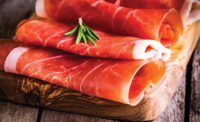Fat Reduction Strategies for Processed Meats

Although not all information is based on solid facts, the idea of meat as an energy-rich food is no longer tenable in developed countries. Health groups—such as the WHO (World Health Organization) - recommend diets in which a maximum of 30% of calories are obtained from fat (10% from saturated fat). Less than 300g of cholesterol should be consumed daily.
The fat content of traditional frankfurters is 20-30%, “nuggets” 20-25%, salami 30-50% and beef patty 20-30%. Reformulating these products may involve both fat reduction and modification of fatty acid composition. Since fat content affects product characteristics such as flavor, juiciness, texture, handling, and heat transfer, to simply reduce fat or replace it with another type is not an option. The following factors need be considered in reformulation efforts.
Sensible Sensory
Generally, fat improves palatability by increasing tenderness and juiciness. In principle, full-fat product attributes are the benchmark for reduced-fat products.However, consumer sensory panels show that a direct relationship between fat and palatability does not always exist. Sometimes, products with intermediary fat levels should be the standard. For example, ground beef with 20% fat was found most acceptable when 5-25% fat products were compared. Fresh pork patties with 40% fat were rated highest when compared to those in a 10-60% fat range.
A minimum desired fat level should be set for a product. For example, at least 3% fat is required in loin of beef and pork for acceptability. A minimal level is difficult to determine when the impact fat has on sensory products is complex—such as in formulated products that undergo processing. The effect fat has on flavor creates a particular challenge.
Seeking Satiety and Safety
Animal fats are sources of liposoluble nutrients such vitamins (A, D, E, K), essential fatty acids, and precursor compounds, such as prostaglandins. It would be useful to know the minimum amount of fat needed in a product to ensure nutritional merit.In regards to calorie contribution, even products that are 94% fat free may account for over 50% of a diet's calorie content. The goal of 30% maximum calories from fat applies to the whole diet, however, not a particular food.
Finally, since lipid digestion is slow, fats produce a sated feeling. If reformulated products do not produce a feeling of satiety, food intake may be increased.
With the same thermal treatment, a lower fat product tends to be less well done than a higher fat product, which may increase microbial survival. One study observed higher microbial numbers as fat levels decreased in fresh pork sausage. Other research showed that under similar smokehouse conditions, a high-fat bologna had higher F-values (i.e., a greater microbial kill) than a 10% fat, water-added bologna.

Water replacement of fat also raises technical problems. For example, the ability to bind water becomes more important. Purge loss is detrimental to appearance and may encourage microbial growth. Drip loss can be decreased with larger portion size, more constant temperatures and avoiding pressure on the product.
If the proportion of mono-unsaturated fatty acid (oleic acid) increases in a fat, its melting point, color and flavor also change. This alters an end product's properties, such as texture and flavor. Processing parameters also may need to be adjusted.
Regs and Cost
Regulations guide nutrient content claims that can be made, ingredients that can be used, and a product's formulation. For example, in the U.S., manufacturers of hot dog and certain other cooked sausages can exchange fat for added water according to the following formula (assuming the finished product's totals do not exceed 40% water and 30% fat): Added water = % moisture minus four times % protein.
It has been estimated that reduced-fat meat products are 10 to 30% more expensive than their full-fat counterparts. This drawback may be offset if consumers perceive lowfat products as a better value for their money.
Feasible Fat Reduction
Fat reduction is most feasible for processed meats that can be classified as either ground and restructured with minimal processing, or products that are comminuted to various degrees and subjected to further processing treatments.
In finely commuted mixtures such as frankfurters, products have been formulated with 1-3% fat levels, although the limit for achieving palatable products with current technology is estimated to be 10%. Further reduction is achieved by substituting some red meat with poultry meat. This, in effect, involves substitution of a gel/emulsion system by a gel.
Fat reduction visibly alters the appearance of coarsely ground dry sausage, since fewer large fat particles appear on its cut surface. One reported option is to replace lard cubes with imitation fat based on a mixture of starch, dextrin, gelatin and skim milk powder or surimi paste.
More finely granulated dry sausages present a challenge, since fat levels increase with moisture loss. A 32% fat level in conventional salami increases to between 45-50% after four weeks of drying. The lowest acceptable fat content for this type of product is generally 20-30%. However, one researcher reports an acceptable 13% fat Milano salami resulted when pregelatinized rind, surimi paste and tapioca starch were used as imitation fat crumbs, along with being processed at a slower dehydration rate.
Assessing Quality
It is essential to assess the extent to which a lower fat product meets its design specifications.Processing affects meat batter properties that, in turn, impact finished product quality. Batter rheological behavior, pH, temperature rise during comminution, and fat distribution in the protein matrix, frequently are analyzed.
Additionally, viscosity, extrusion and shear analysis, among other tests, characterize changes in rheological behavior of comminuted meat systems. This is important in the design of machinery, processes and operations, as well as for end-product characterization. Thermal Scanning Rigidity Monitor is used to evaluate physical changes that take place during formation of the gel structure upon heating.
Fat reduction affects various measurable product characteristics, as well. Fat, protein and moisture levels are the first aspects usually quantified. Fatty acid profile, cholesterol and caloric content, and the presence of non-meat ingredients used in the preparation of lowfat products (e.g., collagen), are others. Besides these, the following checklist should be considered in evaluating a finished product.
- Cooking measurements on yield, shape and size changes; air pockets and degree of doneness.
-
Sensory analysis of firmness, cohesiveness, springiness, juiciness, color and flavor.
-
Instrumental texture analysis of hardness, springiness, chewiness, shear force, force to rupture, etc.
-
Instrumental color measurement that includes lightness, redness and yellowness.
- Flavor analysis of volatile flavor
components.
-
Microbial evaluation, including aerobic and psychrotrophic count, coliforms, mold, yeast, etc.
- Lipid oxidation, such as through use of TBARS (thiobarbituric acid reactive substances).
Through protein interactions, muscle proteins influence water binding, gel forming, emulsification and other properties. Linking molecular forces involved in denaturation and associated events with the properties of processed meats is a challenge. To this end, studies have analyzed protein molecular interactions in the formation of the gel network matrix of low- and high-fat frankfurters. The microstructure of protein gel networks in processed meat helps explain product characteristics such as texture or water binding properties and, hence, helps evaluate the effect of various levels of fat, protein or non-meat ingredients and their location within the matrix.
One final note involves the use of systematic experimental design. To arrive at the best formulation, it is important to experiment with many combinations of components and processing conditions. Complete factorial designs and central composition, rotatable designs are used widely. (See sidebar.)
Public attention to health will continue to drive interest in products with an optimal nutritional profile. The development of lower fat versions of conventional meat products provides an opportunity for the meat industry.

Sidebar
A well-planned experimental design maximizes product development efforts. Single-factor designs compare treatment averages of a single factor at different levels. Complete factorial designs screen factors such as fat content, non-meat ingredients, processing conditions, and storage conditions. Central composite, rotatable designs analyze the influence of fat levels, non-meat ingredients (e.g., tapioca starch, oat fiber, soy protein or salt) and processing conditions (e.g., cooking temperature).Despite the possibilities experimental designs offer, optimization of lowfat meat systems rarely have appeared in published literature. Examples include Beggs et. al. (J. Food Sci. 1997. (62) 1240-1244), who established starch and added water levels for optimum sensory and physical attributes in reduced-fat turkey frankfurters. Chang and Carpenter determined optimum formulations of added water and oat bran on texture in reduced-fat chicken frankfurters. (J. Food Sci. 1997. (62) 194-197, 202).
Linear programming has been used in development of low-cholesterol, lowfat products. (Trends Food Sci. Technol. 1994. (5) 243-254)
Looking for a reprint of this article?
From high-res PDFs to custom plaques, order your copy today!






